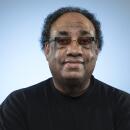Black & White TV
- Share via
It was desperation time for the young African American writer. His voice was mixed with anger and pleading as he tried to persuade the white editor of the hip San Francisco publication to hire him. The magazine wasn’t in touch with the city’s black population, he argued.
“You’ve got a magazine in a major urban center,” the young man said, pointing his finger. “It is in your best interest--you know something, let me rephrase that--it’s your responsibility to reach out and embrace the entire multicultural community.”
Flustered, the editor hired the man on the spot as a freelancer assigned to the “urban scene.”
The exchange took place last November during an episode of “Suddenly Susan,” one of TV’s top-rated situation comedies. Ironically, the applicant’s complaint illustrates a situation found on that very NBC series and many other network television comedies.
At a time when the majority of one-hour dramas feature black and other minority performers in major roles, most prime-time comedies seem to have been developed under a “separate but equal” policy that keeps racial integration to a minimum--or avoids it altogether.
The core casts of “Mad About You,” “Friends,” “Ellen,” “Murphy Brown,” “Frasier,” “Seinfeld,” “Caroline in the City,” “Cybill,” “Life’s Work,” “Wings” and several other comedies are exclusively white. The core casts of “Family Matters,” “Martin,” “Living Single,” “Sparks,” “Malcolm & Eddie,” “In the House,” “The Wayans Bros.” and “The Jamie Foxx Show” are exclusively black.
“There certainly is segregation on the comedies, and I don’t know why that is,” said Winifred Hervey, creator and executive producer of WB’s “The Steve Harvey Show,” a comedy set in an urban high school that has some whites in a predominantly black cast. “It could be because of the experience of the people who do these shows. Maybe there has been no one to enlighten them. It’s certainly a little scary.”
Even on “Suddenly Susan,” where the speech about reaching out was delivered, the regular cast is all white save for one Latino. The character of the young black writer appears only sporadically.
Though many in the industry privately acknowledge the disparity, explaining it is much more difficult. Executives at ABC, NBC, CBS, Fox and UPN declined comment, as did producers from “Mad About You,” “Frasier,” “Friends” and “Seinfeld.”
Observers of the trend are not advocating that every comedy be integrated, or that show producers be required to reflect multiculturalism. “Nobody wants to be told what to create, and they should not be told what to create,” Hervey said.
But some are troubled--others, merely puzzled--that the casting in dramas and comedies is so different.
John Wells, executive producer of the NBC medical drama “ER,” said: “The comedies for some reason just have not been courageous. I certainly was determined to do our show with a multiracial and multicultural focus. It’s irresponsible not to. It does not mirror the society we live in.”
Garth Ancier, head of programming at the WB Network, said that the lack of diversity could be attributed in some instances to the fact that particular shows have small casts or are set in homes or neighborhoods that might not be integrated in real life.
But critics note that many others take place in large workplaces in major cities--the same locales populated by the integrated casts of “NYPD Blue,” “Homicide: Life on the Street,” “Early Edition,” “Dangerous Minds,” “ER,” “Chicago Hope” and “Touched by an Angel.”
Contributing to the disparity, some insiders said, is an atmosphere of increasing competitiveness among the networks and a growing trend toward programming that targets specific audiences or demographic groups.
Comedian Franklyn Ajaye, who has written for such comedies as “In Living Color” and “The Parent ‘Hood,” said: “There used to be a time when America laughed a lot at the same thing. But it’s so niche-oriented now. The network executives all feel that whites and blacks laugh at different things.”
Yvette Lee Bowser, creator and executive producer of Fox’s comedy “Living Single,” about four African American career women, said, “Culturally, we have taken different paths. Our vernaculars and mannerisms differ. It’s nice that there are shows that speak to a different audience, but I would hope that television could provide a window into all worlds so that comedy can be universal again.”
A few observers speculate that the segregated casting may reflect an unconscious failure by comedy creators to acknowledge or deal with racial differences or characters that might detract from their show’s principal comedic point of view. Others say some writers and producers are uncomfortable about depicting characters of another race in a comedic format.
Ajaye said he has pitched comedies with multicultural casts to the networks, “but there is not a lot of enthusiasm for the concept. A lot of writers feel they can’t write for other races. They just want to write what they know. It leads to more racial polarization.”
“Suddenly Susan” isn’t the only comedy series to acknowledge the lack of diversity. An episode this season of NBC’s “NewsRadio” centered on the daydreams of the various staff members, including the show’s only minority character, news anchor Catherine (Khandi Alexander). Her fantasy revolved around taking a break in the lunchroom and being joined by other minority staffers.
In the daydream scene, one of the black men joining Catherine says, “It sure is nice to work in an office that has a few people of color.”
Catherine replies, “You know, the last office I worked at was wall-to-wall white people, chile.”
The black man: “You have to wonder what happened to equal opportunity when you’re the only brother . . . “
Catherine: “Or sister . . . “
The black man: “ . . . in the place.”
When Catherine awakens in the lunch room, she finds herself being joined by several white staffers. Her face drops when one of them asks, “Hey, did anyone see ‘Friends’ last night?”
Bowser said she specifically attempted to address the absence of racial diversity in comedies when she developed this year’s “Lush Life” for Fox, about two female best friends--one white, one black. It got low ratings and was quickly canceled.
“My goal was to have an ethnically diverse comedy world, because that’s the kind of world we live in,” Bowser said. “ ‘Living Single’ is a show about upwardly mobile, young African Americans, and it was important to focus on that because that voice was missing on television. It was culture-specific, but not so culturally specific that everyone could not enjoy it. However, I wanted to do something different with ‘Lush Life.’ ”
Some producers said it is easier and more compelling to deal with racial issues and clashes within the context of a drama than a comedy.
Tom Fontana, executive producer of NBC’s police drama “Homicide: Life on the Street,” said, “One of the things we constantly do on ‘Homicide’ is the dance between the races. Sometimes race is a real issue and sometimes it isn’t, just like real life. We just do stories about people who happen to be black or white.”
On “ER,” producer Wells said, “Race is an issue on our show. We don’t try to minimize it, but the people at the hospital are professional and they have to work together. That’s what occupies their energy.”
Ralph Farquhar, executive producer of UPN’s predominantly black teenage comedy “Moesha,” said he hoped more comedies are developed “which emphasize how connected we are, rather than how disconnected we are.”
“This is America, and it’s unrealistic to have all these shows that are either all white or all black,” said Rocky Carroll, who plays Dr. Keith Wilkes on CBS’ “Chicago Hope.” “This is the most culturally diverse country on the planet, and all kinds of people interact. When we’re not shown interacting, it sends out a message, however subtle. That little box is the most powerful thing in the world. It shapes people’s opinions.”
*
* COSBY BACK TO WORK: Eleven days after his son’s death, Bill Cosby is set to return to his show. F2
More to Read
The complete guide to home viewing
Get Screen Gab for everything about the TV shows and streaming movies everyone’s talking about.
You may occasionally receive promotional content from the Los Angeles Times.







